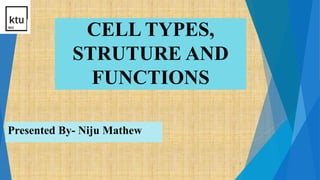
Ppt presentation on cell types, structure and functions (1)
- 1. CELL TYPES, STRUTURE AND FUNCTIONS Presented By- Niju Mathew 1
- 2. CONTENTS INTRODUCTION CELL THEORY PROKAROYTIC AND EUKARYOTIC CELL ANIMALAND PLANT CELL CELL WALL NUCLEUS NUCLEAR MEMBRANE ENDOPLASMIC RECTICULUM RIBOSOMES MITOCHONDRIA GOLGI BODY LYSOSOME CONCLUSION REFERENCES 2
- 3. 3 CELL THEORY All living things are made up of cells. Cells are the smallest working units of all living things. All cells come from preexisting cells through cell division. DEFINITION OF CELL Cells are the basic structures of all living organisms. Cells provide structure for the body, take in nutrients from food and carry out important functions. Cells group together to form tissues, which in turn group together to form organs, such as the heart and brain. Our cells contain a number of functional structures called organelles. Figure 1. Basic plant cell
- 4. DISCOVERY OF CELLS Figure 3. Robert Hooke’s drawings of the cellular structure of cork and sprig of sensitive plant from Micrographia (1665) Cells: small, membrane enclosed units filled with a concentrated aqueous solution of chemicals and endowed with the extraordinary ability to create copies of themselves by growing and then dividing in two Figure 2. Drawing of the microscope set up used by R. Hooke in 1665
- 5. Prokaryotic vs. 5 Eukaryotic • no nucleus • no membrane enclosed organelles • single chromosome • no streaming in the cytoplasm • cell division without mitosis • simple flagella • smaller ribosomes • simple cytoskeleton • no cellulose in cell walls • no histone proteins • nucleus • membrane enclosed organelle • chromosomes in pairs • streaming in the cytoplasm • cell division by mitosis • complex flagella • larger ribosomes • complex cytoskeleton • cellulose in cell walls • DNA bound to histone proteins Figure 4. Prokaryotic cell Figure 5. Eukaryotic cell
- 6. Cell types and functions 6 Figure 6 . Plant cell Animal cell
- 7. Comparison: Plant cells Animal cells 7 Large, central vacuole Chloroplasts Rigid cell wall outside of cell membrane No large, central vacuole No chloroplasts No rigid cell wall
- 8. CELL PARTS ORGANELLES SURROUNDING THE CELL 8
- 9. CELL MEMBRANE Outer membrane of cell that controls movement in and out of the cell Double layer 9 Figure 7 . Cell Membrane
- 10. CELL WALL 10 • Most commonly found in plant cells & bacteria • Supports & protects cells Figure 8 . Cell Wall
- 11. Nucleus NUCLEUS 1. Membranous nuclear envelope 2. Chromosomes of DNA and protein (Histones) 11 Figure 9 Nucleus
- 12. NUCLEAR MEMBRANE 12 Surrounds nucleus Made of two layers Openings allow material to enter and leave nucleus Figure 10 . Nuclear Membrane
- 13. ENDOPLASMIC RETICULUM Moves materials around in cell Smooth type: lacks ribosomes Rough type (pictured): ribosomes embedded in surface 13 Figure 11 . ENDOPLASMIC RETICULUM
- 14. RIBOSOMES 14 Each cell contains thousands Make proteins Found on ribosomes & floating throughout the cell Figure 12 . RIBOSOMES
- 15. MITOCHONDRIA 15 Produces energy through chemical reactions – breaking down fats & carbohydrates Controls level of water and other materials in cell Recycles and decomposes proteins, fats, and carbohydrates Figure 13 MITOCHONDRIA
- 16. GOLGI BODIES 16 Protein 'packaging plant' Move materials within the cell Move materials out of the cell Figure 14 GOLGI BODIES
- 17. LYSOSOME 17 Digestive 'plant' for proteins, fats, and carbohydrates Transports undigested material to cell membrane for removal Cell breaks down if lysosome explodes http://library.thinkquest.org/12413/structures.html Figure 15 LYSOSOME
- 18. CHLOROPLAST 18 Usually found in plant cells Contains green chlorophyll Where photosynthesis takes place http://library.thinkquest.org/12413/structures.html Figure 16 CHLOROPLAST
- 19. CONCLUSION Various parts of the cell function very important but extraordinary functions. Each phase performs the job for which it is chemically and structurally suited; thus, the nucleolus synthesizes protein and ribonucleic acid. A massive phase of the protein synthesis of the cell is carried out through the ribosomes related with the endoplasmic reticulum of the cytoplasm The chromosomes of the nucleus comprise the genes that produce hereditary outcomes in the cell. It also describes that the oxidation things to do of the cell are carried in the mitochondria and that, as a result of respiratory exercise of these structures, ATP is produced, which is available for electricity and structural purposes in the cell. 19
- 20. REFERENCES • Glaser R. Biophysics. - Springler Verlag, 2000. • Alberts B., Bray D., Hopkin K., Johson A., Lewis J., Raff M., Roberts K., Walter P. Essential cell biology. Garland Science. 2014. • Rodney M. J. Cotterill. Biophysics: An Introduction. 2002 • Nabor, Murray W., INTRODUCTION TO BOTANY, Copyright 2004 Pearson Education, Inc., publishing as Benjamin Cummings, 1301 Sansome St., San Francisco, CA 94111 • Kingsley R. Stern, James E. Bidlack & Shelley H. Jansky., INTRODUCTORY PLANT BIOLOGY, Copyright © 2008 by The McGraw- Hill Companies, Inc. Published by McGraw-Hill, 1221 Avenue of the Americas, New Yours, NY 10020. www.mhhe.com • Movement across membranes http://www.biologymad.com/resources/diffusionrevision.pdf Google Advance Image search